New Engine Powers an Old Favorite
Honda’s CR-V plowed into the small sport-utility vehicle market in 1997, taking just one year to outsell Toyota’s pioneering RAV4. Since then, the four-door people mover has become the country’s bestselling small SUV with nearly four million sold, and has been a source of continued sales strength for Honda as car owners gravitate more toward crossover SUVs over sedans.
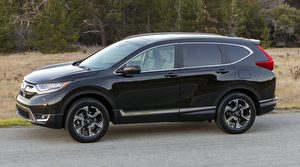
Honda’s come a long way from the spunky original CR-V (which stood for “comfortable runabout vehicle”), with its rear-mounted spare tire and spindly suspension parts visible underneath. To keep the sales momentum going, Honda introduced an all-new fifth-generation CR-V for the 2017 model year, which continues for 2018 with no changes. The new “runabout” comes in four flavors: LX, EX, EX-L and Touring. Pricing starts at $24,150 for the base front-wheel drive LX, with the range-topping Touring with all-wheel drive priced at $34,050. Front-wheel-drive (FWD) remains standard, with all-wheel-drive (AWD) a $1,300 option.
New Turbocharged Engine
There’s a lot to talk about with the new CR-V: styling changes, upgraded interior, safety features and a stellar new turbocharged engine offering. To be price competitive, the CR-V base LX model carries over the proven and reliable
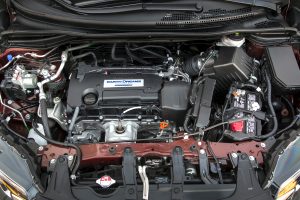
naturally aspirated 2.4-liter direct-injected four-cylinder engine that produces 184 horsepower (hp) and 180 pounds-feet lb-ft) of torque. It continues to be a member of Clean Fleet Report’s All-Wheel Drive 30 MPG Club delivering 31 mpg highway/25 city/27 combined. FWD adds one mpg in each cycle.
All other trim levels get their motivation from a 1.5-liter turbocharged four-cylinder, also used in Honda Civic, that knocks out 190 hp and 179 lb-ft. Unlike some turbo engines, this one is happy drinking regular unleaded gasoline. Both engines have similar horsepower output, but the turbo engine’s advantage is fuel economy. AWD versions return 33 mpg hwy/27 city/29 combined, joining our club. Again, FWD adds one mpg.
Regardless of engine, all 2017-2018 CR-Vs direct engine power to the wheels via a continuously variable transmission (CVT). Honda has been on a mission to improve its CVTs since introduced on the 1996 Civic HX, and it shows. The rubber-band feeling of previous generations is gone, replaced by revs that shoot up high when needed and return quickly to a more efficient—and less noisy—level when not.
A New Look
Though still unmistakably a CR-V, the latest version of Honda’s small SUV is slightly longer, wider and taller than the last generation, giving it more visual presence than before. Just looking at the new CR-V, with its distinctive new front end, sharply flared fenders and a sculpted hood, is a delight. The crossover’s side profile, meanwhile, looks a lot like its predecessor with the sharp, upward angle seen in its rearmost roof pillar. At the tail, the CR-V’s lamps are mounted quite high. Design is subjective, but the new additions add up to a much sleeker and more sophisticated design than the outgoing generation.
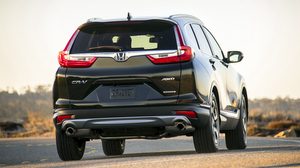
Ground clearance has also increased, from 6.3 inches for FWD models and 6.7 inches for AWD versions to 7.8 and 8.2 inches, respectively. This is particularly good news for CR-V owners who will contend with snow and those who venture off road.
A Delightful Interior
One look at the CR-V’s interior alone may be enough to convince you to buy this SUV, the interior looks and feels high-end. The cabin is roomier—rear legroom increases to a whopping 40.4 inches—and features upgraded materials such as a soft-touch dashboard and exquisitely stitched seats. Upper trims even add handsome imitation wood trim. Typical of Honda, there are no actual gauges in the cluster; just a digital speed readout and a virtual tachometer, which are easy to read at a quick glance. Seats on our CR-V Touring test vehicle had nice leather trim wrapping that looked almost sporty but provided just enough bolstering.
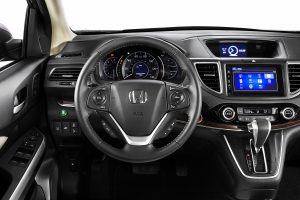
Honda knows its buyers well, as evidenced by some of the small changes, such as returning the radio volume knob, available Apple CarPlay and Android Auto, twin 2.5-amp USB ports in back, a reconfigured center storage bin designed for what real people stash and reshaped door pockets with drink holders that will accommodate bottles as large as one liter in size. Depending on trim, there’s either a five- or seven-inch display screen, and below, the CR-V’s climate control system is simple and intuitive.
Standard equipment includes power windows, locks and outside mirrors; tilt/telescoping steering wheel; air conditioning; cruise control; Bluetooth connection; and a backup camera. Stepping up in trim levels finds pushbutton start, heated power seats, leather upholstery, dual-zone automatic climate control, an upgraded audio system with satellite radio, a navigation system and a sunroof.
Not only is the CR-V’s cabin spacious, but the rear doors open wide, giving lots of elbow room to easily install a child or booster seat. New this year is an available hands-free power tailgate. Like others, it opens the hatch with a sweep of the foot beneath the bumper. Once opened, there’s a class-leading 39.2 cubic-ft. in the cargo area, and 75.8 cubic-ft. with the seat backs folded.
Honda’s CR-V comes standard with the usual allotment of airbag safety equipment, anti-lock brakes and stability control. All but the base LX comes standard with blind-spot, rear cross-traffic, lane-departure and forward collision warning systems, plus automatic emergency braking and lane-departure prevention. This sort of equipment is almost always optional on competitors, and often then restricted to top trim levels.
Competent Driving
Our evaluation Honda CR-V was a fully loaded AWD Touring model with a sticker price of $34,595, including a $900 destination charge. The test model seemed faultless, with nary a squeak or rattle. Knobs and gauges were properly placed and easy to use and see.
As you would expect with a major model makeover, the body became more rigid to improve ride and handling. The independent suspension, front and rear, borrowed from the Civic, is also new. The redesigned CR-V was both comfortable over rough roads and composed around corners. The suspension did a commendable job of striking a balance between the two; it stayed cushioned when cruising but was still tight enough to keep the CR-V from leaning too much around corners. Though not particularly sporty, on country roads the little SUV headed into turns with some eagerness.
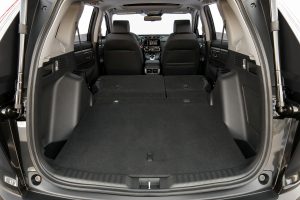
Our CR-V was great around town, even though there was often turbo lag—a slight hesitation between hitting the gas pedal and feeling the full thrust kick in—when pulling away from a stop light. While it wasn’t the quickest thing on four wheels, acceleration was smooth. It always had enough juice to merge into fast-moving freeway traffic and then happily cruise in the far left lane.
Driving at 70-75 mph on the freeway, the CR-V easily exceeded the EPA’s estimate, turning in 36 mpg. Combined fuel economy, after totaling 326 miles, was 31 mpg.
In the Marketplace
In a segment that includes such stalwarts as the Toyota RAV4, Ford Escape, Nissan Rogue, Chevy Equinox and Jeep’s new Compass, this newest CR-V manages to rise to the top. While not the best at every single thing, it’s a top class compact SUV with a great interior, plenty of passenger room, lots of cargo space and excellent fuel economy with the available turbocharged engine.
Related Stories You Might Enjoy:
Road Test: 2017 Toyota RAV4 Hybrid
Road Test: 2017 Ford Escape
Road Test: 2017 Nissan Rogue Hybrid
Tech: 2018 Chevrolet Equinox Diesel
Disclosure:
Clean Fleet Report is loaned free test vehicles from automakers to evaluate, typically for a week at a time. Our road tests are based on this one-week drive of a new vehicle. Because of this we don’t address issues such as long-term reliability or total cost of ownership. In addition, we are often invited to manufacturer events highlighting new vehicles or technology. As part of these events we may be offered free transportation, lodging or meals. We do our best to present our unvarnished evaluations of vehicles and news irrespective of these inducements.
Our focus is on vehicles that offer the best fuel economy in their class, which leads us to emphasize electric cars, plug-in hybrids, hybrids and diesels. We also feature those efficient gas-powered vehicles that are among the top mpg vehicles in their class. In addition, we aim to offer reviews and news on advanced technology and the alternative fuel vehicle market. We welcome any feedback from vehicle owners and are dedicated to providing a forum for alternative viewpoints. Please let us know your views at publisher@cleanfleetreport.com.

15 thoughts on “Road Test: 2018 Honda CR-V Turbo AWD”